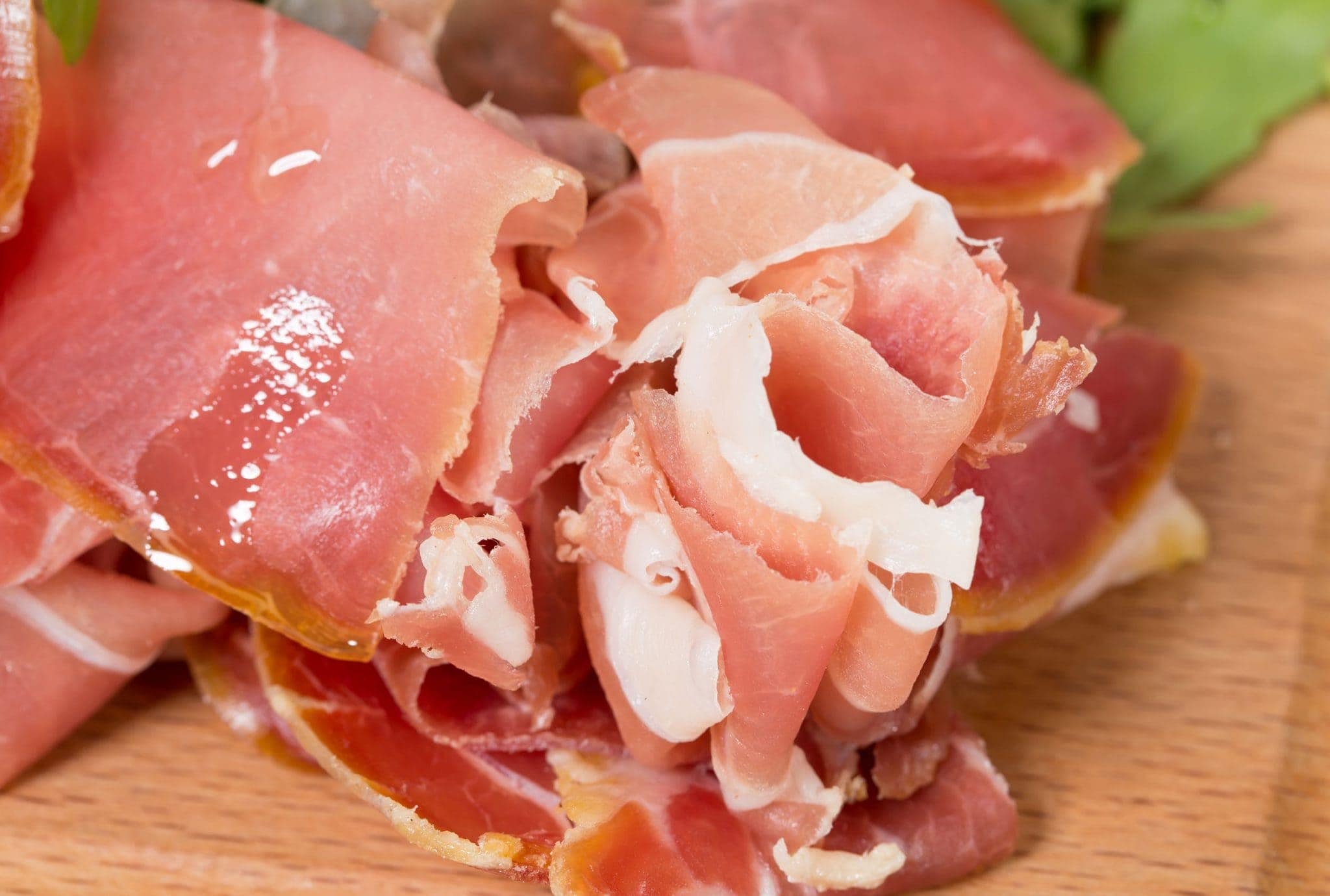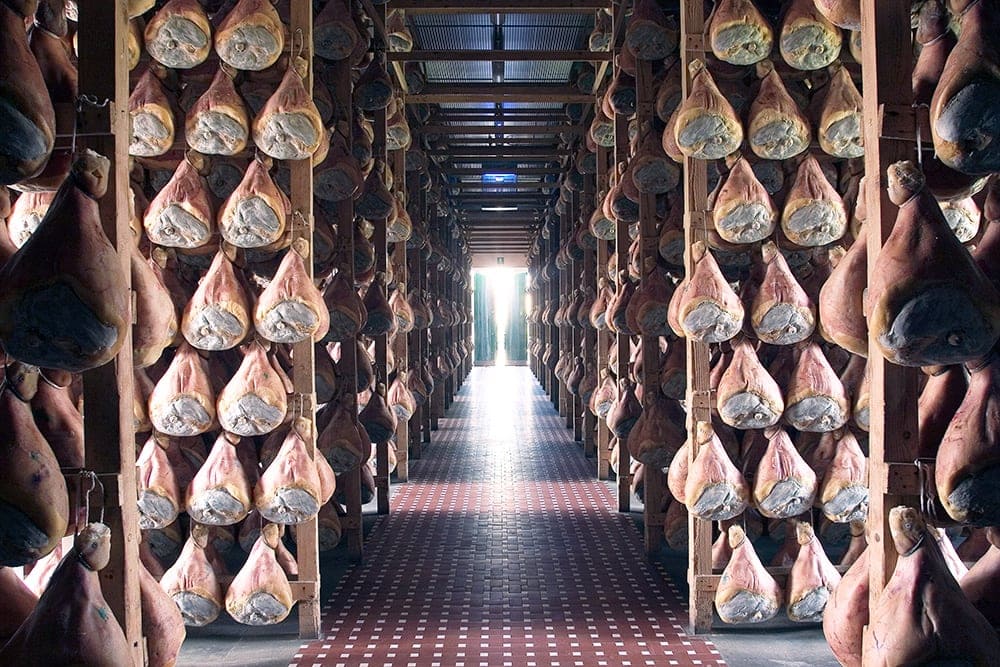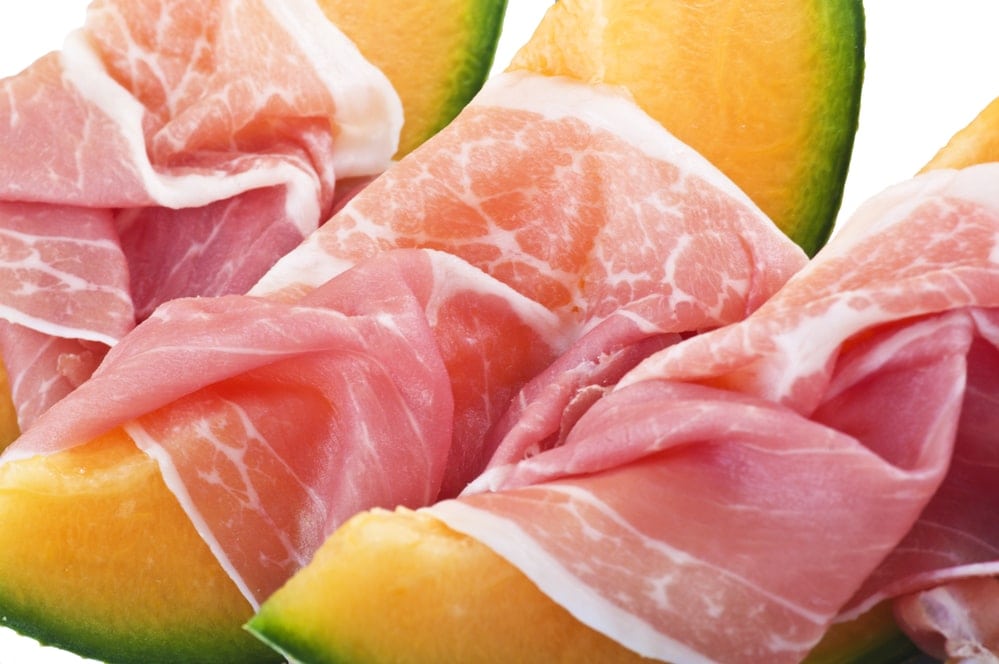Italians are famous for many things: red Ferraris, demonstrative and passionate attitudes, and delicious food that is enjoyed the world over. Speak to virtually any Italian, and you will see that passion and enthusiasm spill over at the mention of food, with prosciutto being one of the favorite dishes served in homes across Italy on a daily basis.


Prosciutto is a specially prepared Italian dry-cured meat that is typically sliced very thinly and served uncooked. Prosciutto evokes a lot of passion and even competition among the regions of Italy, which offer different variations of the dish.
Each variant reflects the distinct flavors and characteristics of the region where they are made, so it is certainly worthwhile to experiment a little to see which variety you prefer. Two of the most famous are Prosciutto di Parma and Prosciutto di San Daniele (see Types of Prosciutto below).
Prosciutto is sold in two varieties: cotto, which is cooked, and crudo, which is raw. Due to the seasoning process in the production of prosciutto, there is no reason why this meat cannot be eaten raw, and that is how the majority of it tends to be consumed.
Prosciutto is cut into very thin slices, leading to a tendency for it to dry out very quickly. Never buy any prosciutto without first asking for a taste. The meat should be pink and have a sweet taste with a hint of salt. Prosciutto is often served as an appetizer, accompanied by melon or asparagus.
Prosciutto is not only one of the most famous Italian foods, but it is also one of the oldest. Records show that as far back as pre-Roman times, in the San Daniele region of northern Italy, Celtic people began to master the art of curing meat with salt. Interestingly, in the Parma region, the local farmers were the leading proponents of prosciutto.
The process of making prosciutto today has barely changed from the ancient methods, and when you taste melt-in-your-mouth prosciutto, it is easy to see why. After all, why tinker with perfection?

Prosciutto is made using only the hind leg, or thigh, of a pig, and the process takes a considerable amount of time—anywhere from nine months to two years.
The first step involves cleaning the meat and applying liberal amounts of salt to remove any remaining blood and moisture as well as inhibit the growth of bacteria.
Then, the salted meat is stored in a cold environment, which is closely monitored to ensure that the optimum conditions are maintained at all times. After two months, the salt is removed and the meat is left to dry or cure for up to 18 months.
As you can see, the entire process is both lengthy and precise but entirely necessary to give the meat that taste we have all come to appreciate.
Traditional types of food are very important to both the culture and finances of a region. The European Union realized this and introduced the protected designation of origin (PDO). The purpose of this designation is to ensure that only products produced in specific regions are allowed to bear the name of that region.
This not only provides some protection for the region but also, from a customer’s perspective, guarantees quality and assures that the product comes from a legitimate source. Not every food type qualifies for this protection, but some prosciutto varieties bear the PDO seal.

To ensure excellent flavor and texture, always buy fresh prosciutto—you should be able to watch the deli clerk slice the meat from the leg. It may be tempting to buy conveniently pre-sliced, packaged prosciutto, but it will never taste as good. Additionally, purchasing fresh prosciutto enables you to have the meat sliced to your preferred thickness.
For the most authentic prosciutto experience, do not use any cutlery; rather, eat with the tips of your fingers. This will help retain the flavor and aroma. Do not remove it from the paper that it was sliced in unless you prefer to eat it with some mozzarella di bufala. Of course, Italians are also experts in producing beautiful bread.
Eating prosciutto placed between slices of bread, often referred to as a panino, is another delicious experience. Check out other types of salami as well, which can be a good way to integrate prosciutto.
Many people think that prosciutto and pancetta are the same product, but there are clear and defined differences between the two. Pancetta is the Italian version of what Americans refer to as bacon.
Prosciutto is made from the hind leg or thigh of a pig, whereas Pancetta is cut from the belly, which is also the part of the pig where bacon comes from. Unlike bacon, which is predominantly smoked, pancetta is normally cured with the use of salt and spices and generally has a much more subtle flavor than bacon.
Pancetta is generally pale red or pink and contains streaks of fat. Nearly all recipes call for it to be cooked, which is another key difference to prosciutto, which is rarely, if ever, cooked. Pancetta is also rarely eaten on its own in Italian cooking; normally it is used to add flavor to a stew or pasta sauce or wrapped around other meat. When it comes to seasoning dishes that contain either of these two types of meat, bear in mind that they are cured using salt, so don’t add too much salt during the cooking process.
Unfortunately, as often happens with delicious food, when it comes to calories, prosciutto doesn’t fare particularly well. An average serving of 2.8 ounces contains about 200 calories, which might not sound too bad until you compare it to something like tuna, which contains about 160 calories. As a result, prosciutto is not as popular as it once was.
Furthermore, prosciutto also has a relatively high percentage of fat content. An average serving contains about 14 grams of fat, 5 of which are saturated. And just when you thought it couldn’t get any worse, prosciutto also contains higher amounts of sodium and cholesterol than would be desirable.
Regarding positive nutritional benefits, unfortunately, the news doesn’t get much better, as the meat contains virtually no dietary fiber and very little, if any, essential vitamins and minerals.
Although prosciutto is clearly not going to win any awards for its health benefits, there is nothing wrong with the occasional treat, and there are very few foods that shout Italian quite as forcefully as prosciutto.
The good news is that prosciutto is a totally natural, gluten-free food. So if you are looking for a way to add some variety to your lunches, then prosciutto may be the perfect option for you.
Prosciutto is one of the oldest foods in the world and has been enjoyed by millions of people over the centuries. Although you could argue that there are healthier alternatives in today’s market, as long as it is consumed in moderation, there is no reason why anyone cannot enjoy the delicious taste of prosciutto.
Prosciutto can take up to two years to produce, and the entire process has quality control measures in place to ensure that high standards are maintained. This obviously adds to the cost, but it ensures that the quality always meets your expectations.
As often happens with Italian foods, most regions of Italy have their own distinct varieties of prosciutto. Unique production methods result in varying flavors, textures, colors, and even shapes. Some even have quality protections in place such as PDO or other designations. Try several varieties and experience the vast flavors of Italy.
Prosciutto crudo refers to the production method rather than the region of origin. Crudo means “raw” or “uncooked,” and this is the traditional type that dates back to at least pre-Roman times. To preserve the meat, prosciutto crudo is cured with salt and sometimes other spices. The resulting thinly-sliced ham is often deep red and marbled with fat.
Like prosciutto crudo, prosciutto cotto is named for its production method, with cotto meaning “cooked.” This more recent variety is bright pink with a lighter flavor than that of prosciutto crudo. It is cooked slowly at controlled temperatures, sometimes after being seasoned or brined with herbs and spices.
Arguably the most famous variety, Prosciutto di Parma is made from Duroc, Landrace, or Large White pigs in the hills of Parma, Italy. Production of this PDO variety is closely monitored and includes a drying time of at least 18 months. Prosciutto di Parma has a saltier flavor with occasional buttery or nutty overtones. Eating it in a panini or other sandwich helps cut down on the saltiness.
Another popular PDO variety, Prosciutto di San Daniele is darker and less salty—many people even describe it as “sweet.” This prosciutto comes from the village of San Danielle Del Friuli, where breezes from the Alpine foothills and the sea meet, producing the perfect combination of humidity and temperature for the curing process. Some prosciutto lovers say that Prosciutto di San Daniele reaches its peak flavor and texture after 16 months. It’s lighter flavor pairs well with cheese and bread.
Although known for its balsamic vinegar, the province of Modena also produces a brightly colored prosciutto. Enjoy its less salty, more aromatic flavor with melon, figs, or other fruit.
This prosciutto gets its earthy, herbaceous flavor from a curing process involving Tuscan spices like garlic, juniper, and pepper in addition to salt. Its strong seasonings pair well with milder dishes, and locals often eat it plain with bread.
Prosciutto Veneto Berico Euganeo received PDO classification in 1996, ensuring that all prosciutto bearing the lion-shaped Veneto brand was produced within the Euganean territory. Its drying time lasts from 12 to 20 months, resulting in a pinkish-red prosciutto with intense sweetness.
Only older, heavier pigs are used for the production of Prosciutto di Norcia, guaranteeing that the ham has a distinct pear shape, contains the perfect amount of fat, and weighs at least 8.5 kilograms (18.7 pounds). This prosciutto is flavorful without being overly salty and has a delicately spiced aroma.
Overall, if consumed in moderate portions, prosciutto can be part of a healthy diet without major consequences – just make sure to watch your sodium intake.
The main animal used to make Prosciutto is the domestic pig (Sus scrofa domestica). This type of animal has been traditionally bred for food production since ancient times in Europe, especially around Italy where Prosciutto originated from.